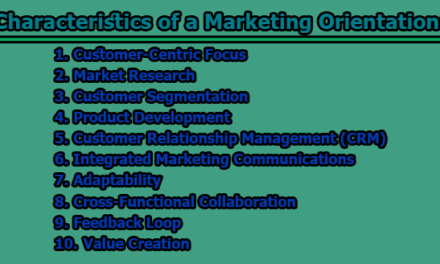Brand Management:
Before diving into the intricate world of brand management, it’s imperative to comprehend the fundamental essence of a brand. A brand is not merely a name or a symbol; it’s a multifaceted entity that distinguishes a manufacturer’s products from those of competitors. Its pivotal role in shaping a product’s success cannot be overstated, as it serves as a beacon, guiding customers through a sea of choices. In the rest of this article, we will explore the brand management: definition, importance, elements, principles, benefits, examples & tips for effective brand management.
Definition of Brand Management:
Brand Management is a marketing discipline that involves strategically developing and nurturing a brand to enhance its perceived value, foster customer loyalty, and create a distinct identity in the market. It encompasses activities such as brand positioning, messaging, visual elements, and overall brand strategy to establish a positive and recognizable image for products or services over time.
Importance of Brand Management:
Brand management plays a crucial role in the success and sustainability of a business. It is a multifaceted process that goes beyond creating a logo or catchy tagline. The significance of brand management can be understood through various aspects:
1. Distinctive Identity: Brand management helps in creating a unique and distinctive identity for a business. In a crowded market, where consumers are bombarded with choices, a strong and recognizable brand sets a business apart from competitors. It ensures that consumers can identify and remember the brand among numerous options.
2. Emotional Connection: Successful brand management goes beyond products or services; it involves creating an emotional connection with the target audience. When consumers connect with a brand emotionally, it leads to increased brand loyalty. This emotional bond can influence purchasing decisions and foster a long-term relationship between the brand and its customers.
3. Customer Loyalty: Brand management is instrumental in building and maintaining customer loyalty. A well-managed brand communicates consistency, reliability, and quality, which are essential factors for earning and retaining customer trust. Loyal customers not only make repeat purchases but also act as brand advocates, recommending the brand to others.
4. Brand Trust: Trust is a foundation for any successful business, and brand management plays a pivotal role in establishing and maintaining that trust. Consistent delivery of promises, maintaining quality standards, and ethical business practices contribute to building a trustworthy brand. Trust enhances the credibility of the brand in the eyes of consumers.
5. Competitive Advantage: In a competitive business landscape, a well-managed brand provides a competitive advantage. It differentiates the business from competitors and becomes a source of preference for consumers. This distinctiveness can be based on factors such as quality, innovation, customer service, or a unique value proposition.
6. Financial Value: Effective brand management contributes to the financial value of a business. A strong brand often commands premium pricing, as consumers are willing to pay more for products or services associated with a trusted and recognized brand. The financial value extends beyond tangible assets and includes the overall reputation and market position of the brand.
7. Market Visibility: Building and managing a brand effectively increases its visibility in the market. A well-known brand is more likely to attract attention and interest from consumers. This heightened visibility leads to increased brand recall, especially when consumers are making purchasing decisions.
8. Employee Motivation: Brand management is not limited to external perceptions; it also influences internal stakeholders, particularly employees. A well-defined and effectively managed brand provides employees with a sense of purpose and direction. It aligns them with the company’s values and goals, fostering a positive work environment and motivation.
9. Adaptability and Innovation: Brands need to stay relevant in a dynamic market. Effective brand management involves continuous monitoring of market trends and consumer preferences. Brands that can adapt to changes and innovate while staying true to their core values are more likely to thrive in evolving business landscapes.
Essential Elements of Brand Management:
Brand management involves a comprehensive approach to shaping and maintaining a brand’s identity, perception, and value in the market. Successful brand management requires careful consideration of several essential elements that collectively contribute to building a strong and resilient brand. Here are the key elements:
1. Brand Position: Brand position refers to the unique space a brand occupies in the minds of consumers relative to its competitors.
- Importance: It communicates the distinct value proposition and differentiating factors that set the brand apart in the market.
- Implementation: Identifying target market segments, analyzing competitor positions, and crafting a compelling brand position that resonates with the intended audience.
2. Brand Promise: A brand promise is a commitment made by a brand to deliver specific benefits, experiences, or values to its customers.
- Importance: It sets expectations and establishes trust with consumers by assuring consistent quality and delivery of the brand’s offerings.
- Implementation: Aligning the brand promise with customer expectations, ensuring transparency, and consistently delivering on the promised experience.
3. Brand Personality: Brand personality refers to the set of human characteristics and traits attributed to a brand, creating a relatable and identifiable persona.
- Importance: It helps in humanizing the brand, making it more engaging and fostering emotional connections with consumers.
- Implementation: Defining key personality traits, aligning them with the brand’s values, and integrating the personality consistently across communications and interactions.
4. Brand Story: A brand story narrates the history, values, and journey of the brand, providing context and building a narrative around its existence.
- Importance: It adds depth to the brand, creates a sense of authenticity, and helps consumers connect with the brand on a personal level.
- Implementation: Crafting a compelling and authentic narrative that reflects the brand’s heritage, values, and achievements, and sharing it through various channels.
5. Brand Associations: Brand associations are the mental connections consumers make between the brand and specific attributes, values, or characteristics.
- Importance: They contribute to shaping brand perceptions and influencing consumer attitudes towards the brand.
- Implementation: Developing consistent visual elements (logo, colors, etc.), messaging, and experiences that reinforce the desired brand associations.
6. Brand Recognition: Brand recognition is the ability of consumers to identify and recall a brand based on visual or auditory cues.
- Importance: It enhances the brand’s visibility and recall value, influencing purchase decisions and fostering consumer loyalty.
- Implementation: Designing distinctive visual elements, logos, and taglines that are easily recognizable and consistently used across all brand touchpoints.
7. Brand Equity: Brand equity represents the intangible value and strength of a brand, including its reputation, consumer perception, and market position.
- Importance: Positive brand equity contributes to consumer preference, loyalty, and the brand’s ability to command premium pricing.
- Implementation: Building brand equity through consistent positive experiences, effective marketing strategies, and maintaining a strong brand image.
8. Brand Marketing: Brand marketing involves strategic activities and campaigns aimed at promoting the brand, creating awareness, and driving consumer engagement.
- Importance: It helps in reaching and connecting with the target audience, reinforcing brand messages, and influencing purchasing decisions.
- Implementation: Utilizing various marketing channels, including digital marketing, advertising, events, and sponsorships, to create a cohesive and impactful brand presence.
9. Brand Performance and Analysis: Brand performance and analysis involve assessing the effectiveness of brand strategies, campaigns, and overall market standing.
- Importance: It enables brands to measure their success, identify areas for improvement, and make informed decisions for future brand management efforts.
- Implementation: Regularly monitoring key performance indicators (KPIs), conducting market research, and analyzing consumer feedback to gauge brand performance.
10. Building Brand Value: Building brand value is a long-term process focused on enhancing the overall worth and perception of the brand in the market.
- Importance: It contributes to the brand’s sustainability, competitive advantage, and ability to command customer loyalty.
- Implementation: Implementing strategies that align with the brand’s mission, vision, and long-term goals, emphasizing quality, innovation, and customer satisfaction.
Principles of Effective Brand Management:
Effective brand management is rooted in a set of principles that guide the development, maintenance, and enhancement of a brand’s identity and perception. These principles serve as a framework for building a strong and resilient brand that resonates with consumers and withstands market challenges. Here are the key principles of effective brand management:
1. Consistency: Consistency involves maintaining uniformity in brand elements, messaging, and experiences across all touchpoints.
- Importance: Consistency builds brand recognition, establishes trust, and reinforces the brand’s identity in the minds of consumers.
- Implementation: Enforcing brand guidelines, ensuring coherence in visual elements, and aligning messaging with the brand’s core values across all platforms.
2. Authenticity: Authenticity is the quality of being genuine, transparent, and true to the brand’s values and promises.
- Importance: Authentic brands connect more deeply with consumers, fostering trust and emotional engagement.
- Implementation: Aligning brand actions with stated values, maintaining transparency in communication, and avoiding practices that may compromise authenticity.
3. Clarity: Clarity involves presenting a clear and easily understandable brand message to consumers.
- Importance: A clear brand message facilitates better understanding, helping consumers grasp the brand’s value proposition and unique attributes.
- Implementation: Crafting concise and straightforward messaging, avoiding jargon, and ensuring that brand communications are easily comprehensible to the target audience.
4. Relevance: Relevance is the alignment of the brand with the current needs, preferences, and aspirations of the target audience.
- Importance: A relevant brand stays top-of-mind and resonates with consumers, ensuring continued engagement.
- Implementation: Staying informed about market trends, consumer preferences, and cultural shifts, and adjusting brand strategies accordingly to remain relevant.
5. Differentiation: Differentiation involves highlighting unique qualities and attributes that set the brand apart from competitors.
- Importance: A differentiated brand stands out in a crowded market, attracting attention and creating a competitive advantage.
- Implementation: Identifying and emphasizing distinctive features, values, or benefits that distinguish the brand, ensuring these differentiators are consistently communicated.
6. Coherence: Coherence is the harmonious integration of all brand elements to create a unified and cohesive brand identity.
- Importance: A coherent brand identity strengthens overall brand perception, making it more memorable and impactful.
- Implementation: Ensuring that visual elements, messaging, and brand experiences align seamlessly, creating a cohesive and unified brand image.
7. Flexibility: Flexibility involves the brand’s ability to adapt to changing market conditions, consumer expectations, and emerging trends.
- Importance: Adaptable brands remain resilient and can seize new opportunities, staying relevant over time.
- Implementation: Continuously monitoring the market landscape, being open to strategic adjustments, and incorporating feedback to evolve with changing dynamics.
8. Emotional Resonance: Emotional resonance is the capacity of a brand to evoke positive emotions and connect with consumers on a personal level.
- Importance: Brands that evoke emotions create stronger bonds with consumers, driving loyalty and advocacy.
- Implementation: Incorporating storytelling, relatable messaging, and experiences that tap into consumers’ emotions, fostering a genuine connection.
9. Adaptability: Adaptability refers to the brand’s readiness to adjust strategies based on consumer feedback, market shifts, and evolving trends.
- Importance: Brands that adapt effectively demonstrate responsiveness and agility, ensuring continued relevance.
- Implementation: Gathering and analyzing customer feedback, monitoring market trends, and making data-driven decisions to adapt strategies proactively.
10. Long-Term Vision: Long-term vision involves setting overarching goals and strategies that align with the brand’s mission and values.
- Importance: Brands with a long-term vision make decisions that contribute to sustained growth, enduring success, and a lasting positive impact.
- Implementation: Developing strategic plans that prioritize long-term brand health, sustainability, and growth, and aligning short-term actions with the overarching vision.
Benefits of Effective Brand Management:
Effective brand management is a strategic investment that yields a multitude of advantages for businesses, ranging from increased market share to enhanced customer loyalty. Here are the benefits of implementing effective brand management:
- Grows Business:
- Increased Market Share: Effective brand management contributes to market expansion and customer acquisition, leading to a growing share of the market.
- Competitive Advantage: A well-managed brand stands out in a crowded market, providing a competitive edge that attracts new customers.
- Cultivates Customer Loyalty:
- Repeat Business: A strong brand elicits customer trust and loyalty, encouraging repeat business as satisfied customers prefer familiar brands.
- Positive Word-of-Mouth: Loyal customers become brand advocates, generating positive word-of-mouth referrals that attract new customers.
- Creates Brand Awareness and Recognition:
- Increased Visibility: Effective brand management enhances brand visibility, making the brand easily recognizable in the market.
- Brand Recall: Consistent brand messaging and visuals contribute to improved brand recall, ensuring that the brand is top-of-mind for consumers.
- Increases Pricing and Value of Product:
- Perceived Value: Strong brands can command premium prices as consumers associate higher value and quality with well-established and reputable brands.
- Price Elasticity: Consumers may be more willing to pay higher prices for products or services associated with a trusted and recognized brand.
- Grows Sales Through Loyal Customers:
- Cross-Selling Opportunities: Loyal customers are more likely to explore and purchase additional products or services offered by the same brand.
- Upselling Potential: The trust established with loyal customers provides opportunities for upselling higher-tier products or services.
- Enhances Employee Morale and Productivity:
- Pride and Belonging: Employees working for a respected and well-managed brand often experience a sense of pride and belonging.
- Motivation: A strong brand identity and positive reputation motivate employees, leading to increased productivity and commitment to organizational goals.
- Supports Advertising Efforts:
- Effective Communication: A well-defined brand facilitates more effective communication in advertising campaigns, ensuring that messages align with the brand’s identity.
- Targeting Relevance: Brand management helps in identifying and targeting the right demographics, maximizing the impact of advertising efforts.
- Improves Financial Performance:
- Increased Revenue: Successful brand management contributes to increased sales and market share, directly impacting the organization’s revenue.
- Market Capitalization: Strong brands often lead to higher market capitalization, reflecting positively on the organization’s financial performance.
- Boosts Confidence and Trust:
- Consumer Trust: Brands with a positive reputation and consistent messaging build trust among consumers, fostering confidence in the brand’s offerings.
- Crisis Resilience: Well-managed brands are more resilient during crises, as established trust mitigates the impact of negative events.
- Fosters Innovation and Expansion:
- Innovation Confidence: A reputable brand encourages innovation, as consumers are more receptive to new products or services from brands they trust.
- Global Expansion: Strong brands are better positioned for global expansion, as their established reputation can transcend geographical boundaries.
- Attracts Investor Interest:
- Investor Confidence: Companies with well-managed brands often attract investor interest and confidence, leading to increased investment opportunities.
- Market Valuation: Strong brand equity positively influences market perception and may contribute to higher market valuations.
- Adapts to Market Changes:
- Resilience to Shifts: Brands that effectively manage their image are better equipped to adapt to market changes, remaining relevant and resilient in dynamic environments.
- Consumer Relevance: A flexible brand can adjust strategies to align with evolving consumer preferences and emerging trends.
Examples of Brand Management:
Brand management is an essential aspect of marketing strategy that involves creating a distinct and positive image for a product or service. Companies employ various strategies to effectively manage their brands, enhance customer perception, and achieve business objectives. Here are some of the examples of brand management in action:
- Apple Inc.:
- Consistent Brand Identity: Apple has successfully maintained a consistent brand identity across its products, emphasizing simplicity, innovation, and premium quality.
- Product Launch Events: Apple’s meticulously planned product launch events contribute to building anticipation and excitement around new releases, creating a buzz in the market.
- Coca-Cola:
- Iconic Brand Design: Coca-Cola’s red and white logo and distinctive contour bottle shape are globally recognized symbols of the brand.
- Emotional Connection: Coca-Cola has consistently focused on creating emotional connections with consumers through iconic advertising campaigns, such as the classic Christmas ads featuring Santa Claus.
- Nike:
- Endorsement and Sponsorship: Nike’s brand management involves strategic endorsements and sponsorships with top athletes like Michael Jordan and Cristiano Ronaldo, reinforcing a connection between the brand and excellence.
- Slogan Impact: The “Just Do It” slogan encapsulates Nike’s brand philosophy, encouraging consumers to embrace an active lifestyle and overcome challenges.
- Google:
- Innovative Brand Extensions: Google, known for its search engine, has successfully extended its brand into various innovative products and services like Google Maps, Gmail, and Google Drive.
- Corporate Social Responsibility (CSR): Google’s commitment to sustainability and environmental initiatives contributes to a positive brand image, aligning with societal values.
- Amazon:
- Customer-Centric Approach: Amazon’s brand management revolves around a customer-centric approach, focusing on convenience, fast delivery, and a seamless online shopping experience.
- Brand Diversification: Amazon has expanded its brand into diverse areas, from e-commerce and cloud services to entertainment streaming, creating a broad and influential brand presence.
- Tesla:
- Innovative Technology: Tesla’s brand is synonymous with cutting-edge electric vehicle technology, positioning the company as a leader in the automotive industry.
- Founder’s Persona: Elon Musk’s public persona and involvement contribute to the brand’s uniqueness, portraying Tesla as a visionary and disruptive force.
- Starbucks:
- Third Place Concept: Starbucks has successfully positioned itself as the “third place” between home and work, creating a comfortable and welcoming environment for consumers.
- Customization and Personalization: Starbucks allows customers to customize their drinks, fostering a sense of personal connection and catering to individual preferences.
- Disney:
- Brand Storytelling: Disney excels in brand storytelling through its animated movies, theme parks, and media franchises, creating a magical and enchanting brand narrative.
- Brand Extensions: Disney’s acquisition of Marvel, Pixar, and Star Wars franchises demonstrates effective brand extension strategies, expanding its influence across diverse entertainment segments.
- Netflix:
- Content Personalization: Netflix utilizes data-driven algorithms to recommend personalized content, enhancing user experience and engagement.
- Original Content Strategy: Netflix’s investment in original content production, including series and movies, strengthens its brand identity as a leading streaming service.
- Adidas:
- Collaborations and Limited Editions: Adidas engages in strategic collaborations and limited-edition releases with designers and celebrities, creating exclusivity and driving brand desirability.
- Athlete Partnerships: Sponsorship deals with athletes like Kanye West and partnerships with sports teams contribute to Adidas’ athletic and lifestyle brand image.
Tips for Effective Brand Management:
Effective brand management is a multifaceted process that requires strategic planning, consistent execution, and a keen understanding of market dynamics. As organizations embark on the journey of brand management, certain tips serve as guiding lights, ensuring that the path to success is well-lit and navigable. Let’s delve into each tip in brief:
- Establish Clear Guidelines:
- Roadmap for Efficiency: Clear guidelines serve as a roadmap for brand management efforts. Organizations should articulate and communicate guidelines that define the roles and responsibilities of team members involved in the brand management process.
- Streamlined Collaboration: Clear guidelines facilitate streamlined collaboration, ensuring that every team member understands their specific contributions to maintaining and enhancing the brand.
- Craft a Unique Brand Strategy:
- Brand Differentiation: A unique brand strategy involves understanding and emphasizing what sets the brand apart from competitors. This includes identifying the brand’s unique value proposition and competitive advantages.
- Target Audience Identification: Effective brand strategies include a deep understanding of the target audience, ensuring that the brand’s messaging resonates with the right demographic.
- Long-Term Planning: Crafting a long-term brand strategy involves setting clear goals and milestones, providing a roadmap for the brand’s development over time.
- Prioritize Customer Experience:
- Bedrock of Brand Management: A positive customer experience is foundational to effective brand management. Prioritizing customer satisfaction ensures that consumers feel valued, appreciated, and heard at every interaction with the brand.
- Building Brand Loyalty: Exceptional customer experiences contribute to brand loyalty, fostering a strong and enduring connection between the brand and its customer base.
- Make Customers the Top Priority:
- Customer-Centric Approach: Aligning with the principle of customer-centricity, organizations must place customers at the forefront of brand management efforts. This involves considering customer needs and preferences in every aspect, from product development to customer service.
- Feedback Mechanisms: Actively seeking and responding to customer feedback helps in refining products, services, and overall brand strategies.
- Centralize Brand Assets:
- Cohesive Brand Identity: A cohesive brand identity is strengthened by centralizing brand assets. Logos, colors, typography, and other visual elements should be organized in a centralized location to ensure consistency across all brand touchpoints.
- Efficient Access: Centralizing brand assets facilitates efficient access for team members, preventing inconsistencies and misusage of brand elements.
- Unify Brand Style for Content:
- Consistent Messaging: Consistency in messaging is crucial for effective brand management. Utilizing one brand style for all content, whether written, visual, or multimedia, ensures a uniform brand message.
- Enhanced Brand Recall: A unified brand style contributes to enhanced brand recall, making it easier for consumers to identify and connect with the brand.
- Encourage Cross-Departmental Collaboration:
- Cohesive Brand Message: Cross-departmental collaboration ensures that the brand message is cohesive across various functions, including marketing, research, content creation, and design.
- Alignment with Organizational Objectives: Collaboration fosters alignment with overall organizational objectives, ensuring that brand management efforts contribute to broader business goals.
- Stay Abreast of Trends:
- Adaptability and Relevance: The dynamic nature of content marketing requires organizations to stay abreast of the latest trends. Leveraging tools like social media analytics enables brand managers to align strategies with emerging trends, ensuring adaptability and relevance in the ever-evolving market.
- Competitive Edge: Staying informed about trends provides a competitive edge, allowing organizations to anticipate shifts in consumer behavior and market preferences.
In conclusion, Brand Management emerges as the storyteller, weaving narratives that capture hearts and minds. It’s the compass that guides organizations through the complexities of the market, emphasizing the uniqueness that sets them apart. Like a well-conducted symphony or a strategic chess game, effective brand management harmonizes every element to create a memorable brand experience. As businesses prioritize customer satisfaction, establish clear guidelines, and embrace trends, brand management becomes the cornerstone of success. In essence, brand management is not just about logos and slogans; it’s about cultivating a brand’s identity, fostering loyalty, and navigating the ever-evolving journey of consumer perceptions.

Library Lecturer at Nurul Amin Degree College










